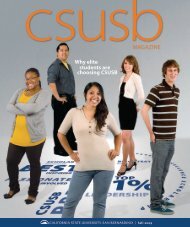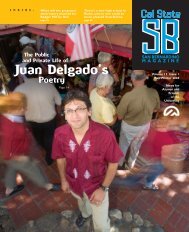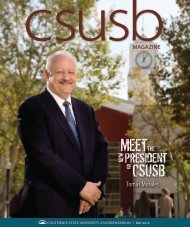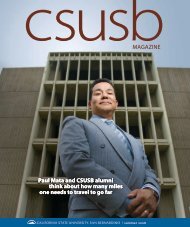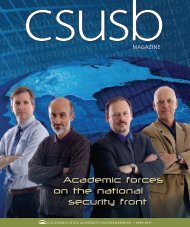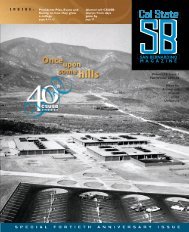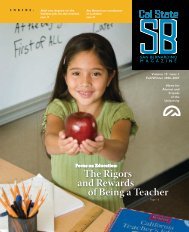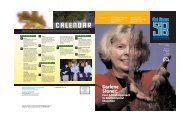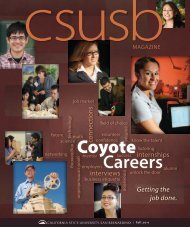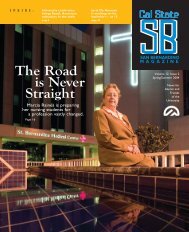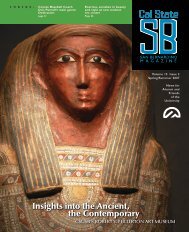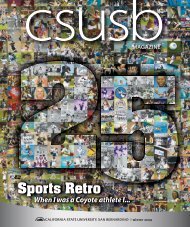CalMagSpr05 ind.indd - CSUSB Magazine - California State ...
CalMagSpr05 ind.indd - CSUSB Magazine - California State ...
CalMagSpr05 ind.indd - CSUSB Magazine - California State ...
- TAGS
- csusb
- magazine.csusb.edu
Create successful ePaper yourself
Turn your PDF publications into a flip-book with our unique Google optimized e-Paper software.
C O L L E G E N E W S<br />
John Conley, dean . . . . . . . . . . . . . . . . . . . . .<br />
RETURN ON THE DOLLAR — Upon the invitation of Tom<br />
Pierce (right), giving to the <strong>CSUSB</strong> economics department was<br />
not a difficult decision for Sean Brunske (left), whose profit<br />
margin was the simple satisfaction of knowing he’d helped<br />
someone. (Photo by Robert Whitehead)<br />
THE MEANING OF DEATH<br />
Some time around 50,000 B.C.,<br />
Neandertals in Europe and the Middle East<br />
began burying their dead with rituals and<br />
grave offerings.<br />
Since then, every society has developed<br />
its distinctive beliefs, ceremonies and obligations<br />
regarding the dead. The exhibit,<br />
“Celebrations of Death,” explores how<br />
human beings conceive of and cope with<br />
death. It is now on display in <strong>CSUSB</strong>’s<br />
Anthropology Museum, located on the third<br />
floor of the College of Social and Behavioral<br />
Sciences Building.<br />
This exhibit samples the diversity, presenting<br />
information, objects and pictures<br />
THE BAND — These figures are from the Mexican portion<br />
of "Celebrations of Death," currently on exhibit at the<br />
Anthropology Museum in the College of Social and Behavioral<br />
Science Building. The exhibit’s 13 stations explore how people<br />
of various cultures conceive of and cope with death.<br />
PAYING IT<br />
FORWARD<br />
from different societies and places such as<br />
the Kwakiutl of British Columbia, rural peasants<br />
in Greece, modern urban China, ancient<br />
Egypt, Victorian England, Buddhist Tibet,<br />
and the tribal peoples of West Africa.<br />
“Funeral ceremonies are designed partly<br />
to ease this transition for the deceased, partly<br />
Social & Behavioral Sciences<br />
By Alan Llavore<br />
Sean Brunske remembers what it was like being<br />
a college student, benefiting from great teaching,<br />
learning with his fellow classmates how to apply their<br />
newfound knowledge in real life, and making lifelong<br />
friends among those students and faculty members.<br />
He also remembers real life itself in those years.<br />
“When I was struggling and started at Cal <strong>State</strong>, I<br />
didn’t have two pennies to rub together. And I was<br />
wondering, ‘How is this all going to work out?’” says<br />
the member of the Class of 1990, who graduated with<br />
a degree in economics. To be sure, there was financial<br />
aid, such as the Pell Grant and student loans. But what<br />
made a difference – and a huge impression on Brunske<br />
– was being named a recipient of a Janczyk Family<br />
Scholarship in his junior year. The money covered the<br />
cost of the fall quarter fees. That was a good $600 that<br />
didn’t have to come out of his pocket. “To me, that<br />
was huge money back then,” he recalls. “When you get<br />
that check, or when financial aid calls you and says your<br />
fees are paid, something changes inside you. For one,<br />
I’m worth something ... It just makes you grateful for<br />
what someone did in the past.”<br />
Now, Brunske, who has his own real estate business,<br />
Evergreen Realty in Upland, wants to help others along<br />
just as he was helped that one memorable quarter with<br />
a scholarship. Working with economics professor Tom<br />
Pierce and College of Social and Behavioral Sciences<br />
development director Cecelia Soriano, Brunske has<br />
established a scholarship fund totaling $10,500 annually,<br />
half of which is to be used to fund a scholarship a<br />
CONTINUED ON PAGE 31<br />
QUICK TAKES<br />
The student population at<br />
Cal <strong>State</strong> San Bernardino<br />
has gotten younger. That’s<br />
younger as in 3-months-old<br />
younger. Of course, these<br />
students aren’t officially<br />
enrolled at the university.<br />
But they are part of the<br />
Institute of Child Development<br />
and Family Relations’<br />
new Infant/Toddler Center,<br />
which opened its doors in<br />
March. The center is geared<br />
to serve children 3 months<br />
to 3 years old, providing<br />
quality child care on campus<br />
while also providing a<br />
nursery school lab setting<br />
for undergraduate and<br />
graduate psychology students<br />
specializing in child<br />
development. The center<br />
operates from 7:30 a.m.<br />
– 6 p.m. Monday-Thursday,<br />
and 7:30 a.m. – 4:30 p.m.<br />
on Friday. The facility is<br />
located on the first floor<br />
of the College of Social<br />
and Behavioral Sciences<br />
Building.<br />
to ease the equally trying transition for<br />
survivors,” said Russell Barber, museum<br />
director and anthropology professor.<br />
“Thus, a funeral and any other memorial<br />
ceremony is an intimate mixture of sorrow,<br />
grief, joy and hope. In death there is celebration,<br />
as well as sadness.”<br />
11<br />
Spring/Summer 2005 <strong>CSUSB</strong>



